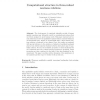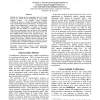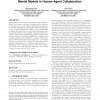514 search results - page 13 / 103 » Cognitively Plausible Models of Human Language Processing |
COSIT
2001
Springer
14 years 6 days ago
2001
Springer
The development of cognitively plausible models of human spatial reasoning may ultimately result in computational systems that are better equipped to meet human needs. This paper e...
SEMCO
2009
IEEE
14 years 2 months ago
2009
IEEE
—CSML is a semantic markup language created for the publishing and sharing of conceptual spaces, which are geometric structures that represent semantics at the conceptual level. ...
COGSR
2011
13 years 2 months ago
2011
Methods for cleaning up (or recognizing) states of a neural network are crucial for the functioning of many neural cognitive models. For example, Vector Symbolic Architectures pro...
ATAL
2007
Springer
14 years 1 months ago
2007
Springer
Human team members often develop shared expectations to predict each other’s needs and coordinate their behaviors. In this paper the concept “Shared Belief Map” is proposed ...
CORR
2006
Springer
13 years 7 months ago
2006
Springer
It is well known that perspective alignment plays a major role in the planning and interpretation of spatial language. In order to understand the role of perspective alignment and...



